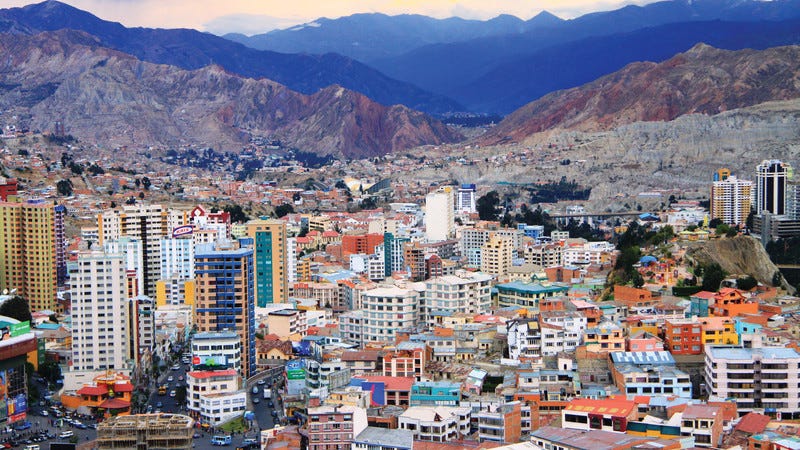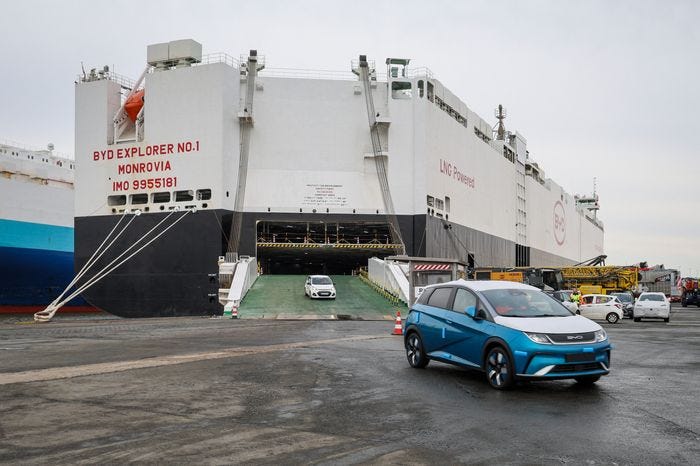Emerging Markets Monitor - April 23
Hong Kong's Biggest 2024 IPO Flops, Bolivia's Bust Fuels Political Unrest, GCC Economies Resilient, Copper Shortages Fuel Price Rises, EV's Rising: IEA
The Top Stories Shaping Emerging Markets from Global Media - April 23
Hong Kong’s Biggest IPO of 2024 Flops
Financial Times
“Hong Kong’s biggest initial public offering of the year flopped on Tuesday as shares of Chinese bubble tea chain ChaPanda dropped as much as 38 per cent from its listing price in its trading debut.”
“ChaPanda, also known as Chabaidao, raised almost HK$2.6bn (US$331mn), with shares priced at HK$17.50. The public offering, only 0.5 times subscribed, comes as the city struggles to revive its stock market.”
“Hong Kong’s benchmark Hang Seng index has fallen more than 15 per cent over the past year. IPOs in Hong Kong raised a total of $604mn in the first three months of this year, down 29 per cent from last year and making it the lowest start to a year by proceeds since 2009, according to data compiled by the London Stock Exchange Group.”
“…The market for tea chains such as ChaPanda in mainland China was Rmb104bn ($14bn) in 2022, almost double the market size in 2018, according to the China Chain Store & Franchise Association.”
“…But Dickie Wong, executive director of research at Hong Kong-based Kingston Securities, said bubble tea chains were likely to find maintaining customer loyalty difficult in a competitive arena…After this IPO the sentiment will even get worse because they received an undersubscription and this gives a very bad impression that Hong Kong’s IPO market is simply not effective,’ he added. ‘The overall market will remain lukewarm.’”
“Hong Kong’s stock exchange is ranked 10th on the LSEG’s global IPO stock exchange rankings in the first quarter, behind Mumbai and Shanghai, despite listings on the mainland also collapsing to record lows. The city’s Hang Seng index declined for a fourth consecutive year in 2023. Gary Ng, a senior economist at Natixis, said Hong Kong would probably face the ‘double whammy of elevated US interest rates and weak confidence in China-related assets’ for the rest of this year. Ng added that IPOs might still attract anchor investors but not cornerstone investors, showing the market was ‘not comfortable locking their capital in new Hong Kong listings’.” The FT reports.
Bolivia’s Boom Has Turned to Bust, Fueling an Unlikely Presidential Comeback Bid
Bloomberg
President Luis Arce is proud of taming inflation. But a long-brewing financial crisis puts that signature achievement at risk, potentially opening the way for his mentor-turned-rival, Evo Morales.
“Signs of Bolivia’s emerging financial crisis are not hard to find on market day in the world’s highest major city, where customers are starting to feel the pinch after the nation’s currency peg to the dollar effectively collapsed, sending prices soaring.
“…One of Latin America’s fastest-growing economies earlier this century, Bolivia is shuddering to a halt. The nation of 12 million is being buffeted by a financial storm long in the making, which has its roots in the end of a natural-gas boom and the country’s failure so far to capitalize on its massive reserves of lithium.”
“That’s fanning a conflict between President Luis Arce and his presidential predecessor, Evo Morales, who is vying to make a comeback even in the face of a 2023 Constitutional Court ruling that bars him from seeking another term.”
“The deteriorating economic outlook poses a threat to Arce’s grip on power, as a shortage of hard currency starts to freeze up foreign trade…Jimena Ugrinovic, whose family imports fertilizers, pesticides and agricultural machinery, says she can no longer easily get dollars to pay suppliers in China, India and Israel on time. That threatens to hit the soy and beef producers who have powered much of the nation’s recent economic growth.”
“..Turmoil in Bolivia is a further blow to the once-dynamic Andean region, which was among the best-performing among emerging markets early in the century, but which is now mired in weak growth, legislative gridlock and popular discontent, from Colombia to Chile.”
“Bolivian neighbor Peru’s political system is on the ropes, Argentina is in the early stages of experimental shock therapy to tackle inflation approaching 300%, while to the northeast, Ecuador is grappling with twin economic and security crises.”
“The trouble at home is bolstering the prospects of Morales, 64, a former llama herder who rose to become Bolivia’s first Indigenous president in 2006. His early successes made him an icon of Latin American socialism, but he was forced out in 2019 after a disputed election.”
“Morales is plotting a return to power after feuding with Arce, 60, a UK-educated economist who was once his protege…One national poll found that Arce has about twice as much support as Morales within the ruling party as a whole. But the president’s backing is likely to wane if the government can no longer afford to heavily subsidize food and fuel, or if the dollar shortage stokes inflation.”
“…Much of Bolivia’s strong economic performance under Morales was due to a boom in natural gas exports, which are now in steep decline. In 2022, the country became a net importer of energy for the first time in decades.”
“Bolivia’s policymakers have for years failed to rein in the fiscal deficit or invest enough in gas exploration, hoping that sooner or later the nation’s vast lithium deposits would generate a tsunami of money that would bail them out. But now the long-anticipated crisis has arrived and the country still isn’t producing the battery metal in significant quantities — even if its price hadn’t collapsed. Australia, Chile and Argentina are meanwhile cashing in on the electric-vehicle boom.”
“…Bolivia’s sovereign dollar bonds are trading at distressed levels, with a yield above 20%, effectively cutting the country off from global credit markets. The government can no longer easily borrow from multilateral lenders either, since the split with Morales has effectively deprived Arce of the congressional majority needed to approve loans from abroad.” Bloomberg reports.
GCC Economies Forge Ahead Despite Geopolitical Risks
The National
“The global growth forecast was revised slightly higher to 3.2 per cent in 2024, from 3.1 per cent…with the improvement largely due to greater resilience to higher interest rates in the advanced economies, particularly the US.”
“The growth forecast for the Middle East and Central Asia was revised slightly lower – to 2.8 per cent in 2024, from 2.9 per cent in January – largely due to the impact of conflict on trade and economic activity, as well as high debt levels in low-income countries in the region.”
“However, the outlook for the GCC economies remains relatively robust, with non-oil growth forecast at 3.6 per cent this year and a predicted headline gross domestic product growth of 2.4 per cent.”
“Emirates NBD’s non-oil growth forecast for the GCC is also 3.6 per cent for 2024, slightly slower than the 3.9 per cent estimated for last year. Survey data shows that non-oil growth was robust in the first quarter of 2024, with the purchasing managers' index for the UAE and Saudi Arabia in the mid-50s, well in expansion territory and stronger than the global composite PMI in the March quarter.”
“…The market has significantly repriced expectations for interest rate cuts from the US Federal Reserve, with only 50 basis points of cuts now expected, rather than the 150 bps in cuts anticipated at the start of the year. Consequently, monetary policy in the GCC will remain tight, deterring some private sector investment and constraining household consumption.”
“…The strong balance sheets of GCC governments should allow them to continue to invest in infrastructure and other strategic sectors even against a backdrop of high interest rates, as sovereign debt levels remain low, particularly when compared with oil-importing countries in the region.”
“…Extended periods of uncertainty and elevated geopolitical risk may also deter foreign direct investment into the region over the medium and longer term, increasing the requirements for funding from the public sector, local banks and the domestic private sector.” Khatija Haq, chief economist of Emirates NBD, writes.
Shortages Key to Copper’s Upward Price March
Reuters
“Upward momentum that has propelled copper prices to within a whisker of the psychological $10,000 a metric ton mark is expected to be sustained by the appearance of shortages over the coming months.”
“Copper prices have recently been bolstered by expectations of tight supplies and optimism about demand prospects from energy transition applications such as electric vehicles and new technology such as artificial intelligence and automation.”
“A pick-up in manufacturing activity, particularly in top consumer China where surveys of purchasing managers have started to show expansion has also contributed to enthusiasm for copper which this week hit a two-year peak at $9,988 a ton for a gain of 25% since early October.”
“Prices accelerated higher last year after the prospect of shortages of copper concentrate, a feedstock for metal, was raised by the closure of Canadian miner First Quantum's Cobre mine in Panama.”
"‘The overarching reality is that we've lost a million tonnes of supply to mine disruptions and the industrial cycle has turned a corner,’ said Piotr Ortonowski, analyst at Benchmark Mineral Intelligence. ‘The long-term energy transition demand story against a backdrop of underinvestment in new mine supply remains intact.’”
“Copper's gains have been partly triggered by the reversal of short -- bets on lower prices -- positions taken when the outlook for Chinese demand looked decidedly gloomy due to shrinking manufacturing activity.” Reuters reports.
IEA Gives Upbeat EV Outlook Fueled by China
Nikkei Asian Review
“Almost one in three cars on the road in China and more than one in five in the U.S. and Europe will be electric by 2030, the International Energy Agency (IEA) forecast in a report released Tuesday.”
“This year alone, around 20% of cars -- or 17 million units -- sold worldwide will be electric vehicles, according to the intergovernmental body's Global EV Outlook 2024 report. This comes on the back of a record year for EV manufacturers, which sold 14 million such vehicles in 2023, a rise of 35% from the previous year. EVs accounted for 18% of car sales worldwide in 2023, a rise of four percentage points over 2022.”
"‘Rather than tapering off, the global EV revolution appears to be gearing up for a new phase of growth,’ IEA Executive Director Fatih Birol said in a statement. ‘The wave of investment in battery manufacturing suggests the EV supply chain is advancing to meet automakers' ambitious plans for expansion. As a result, the share of EVs on the roads is expected to continue to climb rapidly.’”
“More than half of all EVs were manufactured by Chinese automakers in 2023, compared with just 10% of combustion engine cars. China was the largest car exporter in 2023, selling around 4 million units overseas. Of those, 1.2 million were EVs.”
“Chinese companies such as BYD are the biggest winners in the growing EV market, given their large manufacturing capacities and government subsidies that allowed them to undercut prices and swamp some markets. The IEA estimates that 60% of EVs sold in China are already cheaper than combustion engine cars. Elsewhere, it expects price parity only by around 2030.”
"Rather than tapering off, the global EV revolution appears to be gearing up for a new phase of growth"
IEA Executive Director Fatih Birol
“The manufacturing boom in China is turning up the heat for U.S. and European carmakers. Most Chinese exports were headed to Europe and the Asia-Pacific region.”
"‘European and U.S. carmakers are under growing pressure as Chinese carmakers start to export at scale, and are adjusting corporate strategy accordingly,’ said the report. It pointed to statements by Ford and General Motors in February about teaming up to compete against Chinese carmakers, notably BYD. Both Ford's and GM's EV divisions are making losses.” Mailys Penne-Lassus reports.
“To live without hope is to cease to live.” - Fyodor Dostoevsky





